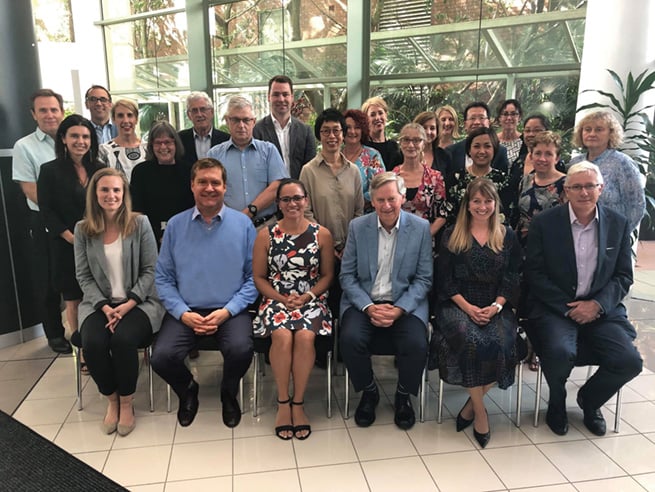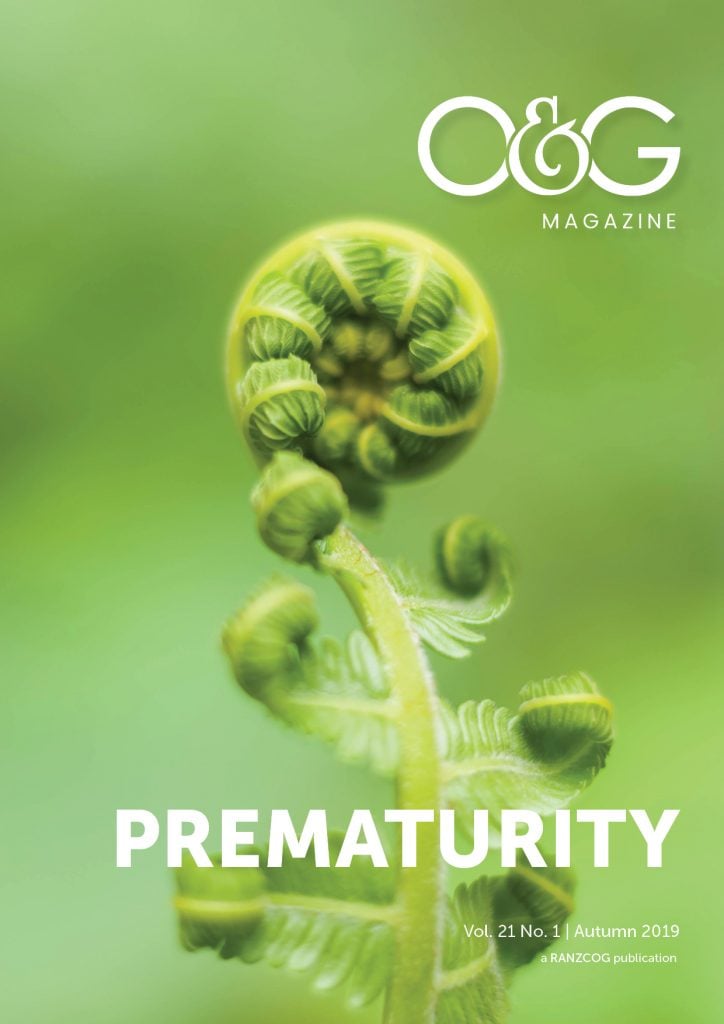The Australian Preterm Birth Prevention Alliance was born on 7 June 2018. This Alliance is the world’s first national program aiming to safely lower the rate of early birth across its population.
Preterm birth is the largest cause of death in children up to five years of age and contributes greatly to long-term illness and disability.1 Discovering how to prevent this major complication of pregnancy needs to be one of the highest priorities for our profession and our community. Until recently, implementation of a whole-of-population strategy was nothing more than a researcher’s dream, but a variety of recent discoveries have made the assembling of an effective program possible.2
In 2014, Western Australia hosted a statewide program known as the Western Australian Preterm Birth Prevention Initiative, consisting of seven interventions, as shown in Box 1. Priority was given to avoidance of elective delivery before at least 38+ weeks gestation without medical or obstetric justification; routine measurement of the length of the cervix at all mid-pregnancy ultrasound scans; prescription of natural vaginal progesterone for shortened cervix or past history of spontaneous preterm birth; promotion of smoking cessation; and a dedicated new clinic in the tertiary-level perinatal hospital.
Key interventions to prevent preterm birth
- No pregnancy to be ended prior to 38+ weeks gestation unless there is a clear medical or obstetric justification
- Measurement of cervix length to be included in all mid-pregnancy morphology scans, conducted routinely at 18–20 weeks gestation
- Natural vaginal progesterone 200 mg to be prescribed nightly in any case in which the cervix is found to be <25 mm on transvaginal scan between 16 and 24 weeks gestation
- In cases in which the cervix is found to be <10 mm, management can include cerclage, vaginal progesterone, or both
- Natural vaginal progesterone 200 mg to be prescribed nightly in any case with prior history of spontaneous preterm birth (with or without pre-labour rupture of membranes) between 20 and 34 weeks gestation
- Women who smoke during pregnancy to be offered appropriate cessation strategies
- A new dedicated Preterm Birth Prevention Clinic established at the tertiary centre
Implementation of the program was accompanied by an intensive social media campaign known as The Whole Nine Months, print material distributed across the state, and an outreach program consisting of workshops for healthcare practitioners across metropolitan and rural Western Australia. At the heart of the Initiative was a philosophy of providing education to the pregnant women of the state, in partnership with their healthcare providers.
In the first full calendar year after introduction (2015), the rate of preterm birth state-wide fell by 7.6 per cent and in the tertiary-level centre by 20 per cent.3 The reductions extended down to the early gestational age groups. This early success led to a successful application to NHMRC for a Partnership Grant involving Western Australia, New South Wales and Victoria, awarded in April 2018. The funding was provided to extend the Initiative in Western Australia and to roll out various versions of the program across our two most populous states. A decision was then made by key representatives from each state and territory to apply the partnership across the nation as a whole and, in June 2018, the Australian Preterm Birth Prevention Alliance was established.
The Alliance has a single aim of safely lowering the rate of preterm birth across Australia. In essence, The Whole Nine Months social media program will now become national and with adaptations tailored for the special circumstances within each jurisdiction.
The organisation sits within the Perinatal Society of Australia and New Zealand (PSANZ) as one of its sub-committees. Each of our six states and two territories has two co-leaders; typically a senior obstetrician accompanied by a more junior clinician. Special expertise is provided by the Chief Investigators of the NHMRC Partnership Grant and members representing the fields of neonatology, midwifery, biostatistics, health economics; health policy; consumer representation; media and marketing; and philanthropy. Together the 30 members sit on a Steering Committee with six members comprising an Executive.
Each year, the Alliance will hold a dedicated workshop immediately before the PSANZ Conference, typically in March, which all registrants are welcome to attend. The progress for each state and territory will be presented, along with discussion of special initiatives under consideration.
The challenges facing the Alliance are clear and the opportunities are plentiful. The rate of preterm birth is rising progressively, largely as a result of intervention in the late preterm and early term age groups.4 Evidence is accumulating that birth at these times may be associated with significant developmental, behavioural and educational problems at school age.5 The consequences in later ages in terms of lifetime productivity and fulfilment are poorly understood, but likely to also be important. Consequently, the potential risks associated with increasing rates of birth in the late preterm and early term age groups are now clear. There may be consequences for individuals, families, communities and perhaps our nation as a whole.
Over recent decades it has become clear that events before and around birth may have lifelong consequences. This understanding has brought obstetric care to the forefront of healthcare. And it is in the field of preterm birth prevention that we obstetricians may have the greatest opportunity to play our part in creating a better community for tomorrow.
The Alliance will now play a central role in identifying prevention strategies that are effective and feasible for our healthcare system, assisting with implementation for our various communities, evaluating the benefits of their introduction, identifying appropriate research priorities, and mentoring the next generation of thought leaders. As the world’s first such national program, the Alliance will also play an important role in facilitating the development of preterm birth prevention strategies elsewhere and partnering with the many potential agencies active in this important area of healthcare.
Every healthcare practitioner who works in the field of reproduction has a role to play in our goal to prevent early birth. The Alliance will provide a platform to lead and coordinate, but our collective success will require commitment from our entire workforce, in partnership with the community we serve, across the many and varied healthcare environments in Australia.
The Australian Preterm Birth Prevention Alliance Executive Committee Members
- John Newnham: Chair
- Jonathan Morris: Deputy Chair
- Euan Wallace
- Kiarna Brown
- Lindsay Edwards
- Monika Skubisz
Steering Committee Members
- Northern Territory Kiarna Brown: Co-Lead, Carina Cotaru: Co-Lead
- Queensland David Elwood: Co-Lead, Chris Lehner: Co-Lead, David Watson: Co-Lead (Far North)
- New South Wales Natasha Donnolley: Consumer Representative, Jane Ford: Perinatal Epidemiologist, Jonathan Morris: Co-Lead, Michael Nicholl: Health Policy, Tanya Nippita: Co-Lead
- Australian Capital Territory Boon Lim: Co-Lead, Maylene Pineda: Co-Lead
- Victoria Jeanie Cheong: Neonatologist, Tanya Farrell: Health Policy, Stefan Kane: Co-Lead, Jeremy Oats: Health Policy, Euan Wallace: Co-Lead
- Tasmania Amanda Dennis: Co-Lead, Lindsay Edwards: Co-Lead
- South Australia Rosalie Grivell: Co-Lead, Paula Medway: Midwifery, Philippa Middleton: Perinatal Epidemiologist, Monika Skubisz: Co-Lead
- Western Australia Catherine Arrese: Alliance Manager, Alicia Bauskis: Health Care Economist, Hugh Dawkins: Health Policy, Dorota Doherty: Biostatistician, Richie Hodgson: Marketing and Media, John Newnham: Co-Lead, Deb Portughes: Philanthropy, Scott White: Co-Lead

Figure 1. Members of The Australian Preterm Birth Prevention Alliance, November 20, 2018.
References
- Chang HH, Larson J, Blencowe H, et al. Preventing preterm births: analysis of trends and potential reductions with interventions in 39 countries with very high human development index. Lancet. 2013;381(9862):223-34.
- Newnham JP, Dickinson JE, Hart RJ, et al. Strategies to prevent preterm birth. Front Immunol. 2014;5:584.
- Newnham JP, White SW, Meharry S, et al. Reducing preterm birth by a statewide multifaceted program: an implementation study. Am J Obstet Gynecol. 2017;216:434-42.
- McCabe ER, Carrino GE, Russell RB, Howse JL. Fighting for the next generation: US Prematurity in 2030. Pediatrics. 2014;134:1193-9.
- White SW, Newnham JP. Is it possible to safely prevent late preterm and early term births? Semin Fetal Neonatal Med. 2018.






Over forty years ago in Canberra I had a daughter at 34 weeks who had severe respiratory distress. Two years later I was diagnosed with a grade four placenta praevia and spent fourteen weeks in hospital before my waters broke at 32 weeks. That baby had a collapsed lung at eight days of age. Both of those babies had lengthy stays in hospital but were breast fed under 15 months each. They are now successful adults.
My daughter had an IVF baby in 2013 after a healthy pregnancy and labour. In 2018 however she gave birth to a 19 week old foetus (IVF) who only lived for three hours. She
is currently in her 20 th week of a third pregnancy.
Because of our extensive involvement in the world of prematurity, I am delighted to hear of your work and will be sending this information to the U.S. where she and her partner live.